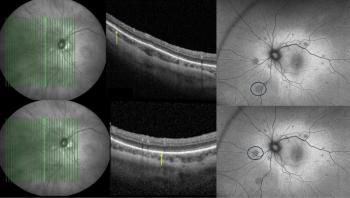
LEAD Study: Reducing AMD Progression Rates with Subthreshold Nanosecond Laser in Eyes with No Pseudo-Drusen
Robyn Guymer, MBBS, PhD, Deputy Director, Centre for Eye Research Australia, and Professor of Surgery (Ophthalmology), University of Melbourne, Australia, discussed the study findings at the 23rd annual EURETINA Congress in Amsterdam, the Netherlands
Reviewed by Robyn Guymer, MBBS, PhD
Investigators from the LEAD Study reported that subthreshold nanosecond laser (SNL) may reduce the rate of progression to late age-related macular degeneration (AMD) as long as no reticular pseudo-drusen (RPD) is present. Robyn Guymer, MBBS, PhD, Deputy Director, Centre for Eye Research Australia, and Professor of Surgery (Ophthalmology), University of Melbourne, Australia, discussed the study findings at the 23rd annual EURETINA Congress in Amsterdam, the Netherlands.
“It is biologically plausible that SNL treatment could be beneficial in AMD by modulating retinal pigment epithelial [RPE]-mediated turnover of Bruch membrane [BM], so as to reduce resistance across BM and improve the RPE health. Our results suggest that SNL treatment has the potential to reduce the rate of progression to late AMD in eyes without RPD,” she said.
Guymer credited John Marshall, PhD, FRCP, with the use of SNL. He forwarded the hypothesis that “a deficiency in the normal turnover of Bruch membrane extracellular matrix, due to insufficient levels of active matrix metalloproteinase [MMPs] enzymes is a potential mechanism for the age-related deterioration in nutritional support of the RPE and photoreceptors.”
An early study1 showed that in vitro, laser-induced proliferation of RPE in turn resulted in release of copious quantities of activated MMPs. This prompted the question: could a nonthermal (very short pulse) laser targeting the RPE be designed to specifically trigger a rejuvenating response in the RPE, leading to clearance of the debris from BM, thus turning back time?
NovaEye (formerly Ellex) developed 2RT Laser-Retinal Rejuvenation Therapy to trigger photo-regeneration of the RPE by delivering 3-nanosecond, non-thermal pulses to the tissue that did not cause collateral damage. This proved successful with the thinning of the BM in treated murine models and increases in the MMPs.2
Ina human extenerated eye, the initial 2RT laser resulted in a defect in the RPE monolayer that was filled rapidly with enlarged RPE cells.
LEAD Study
This investigation3-5 was a two-arm, parallel, randomised, controlled, proof-of-concept study of SNL treatment in patients with intermediate AMD. All patients were excluded if they had multimodal imaging-defined late AMD, ie, choroidal neovascularisation (CNV), geographic atrophy (GA), or nascent GA (nGA). nGA is defined on spectral-domain optical coherence tomography as subsidence of the outer plexiform layer (OPL) and inner plexiform layers and/or a hyporeflective wedge-shaped band in the OPL.
A total of 292 participants were included who had bilateral large drusen (>125𝜇m) in the central 1,500 𝜇m from the fovea. The participants were randomised 1:1 to SNL(2RT) or sham treatment (flashes of light) to the study eye at 6-month intervals for 36 months.
In the LEAD trial, the endpoint of progression was the development of late AMD, defined as either the presence of CNV or GA as well as the earlier atrophic endpoint of nGA as seen on multimodal imaging and in eyes that would still be classified as intermediate AMD.6
The 3-year results showed that 45 (15.4%) randomised participants developed late AMD in the study eye, of which 20 participants were in the SNL treatment group and 25 were in the sham treatment group.
“Overall,” Guymer commented, “progression to late AMD was not significantly slowed with SNL compared to sham treatment.”
Post-hoc analysis
She stated, “Due to our current understanding of how the 2RT laser works, by causing selective RPE loss, it is biologically plausible that the laser’s impact and therapeutic effect could differ depending upon the degree of RPE dysfunction that might be indicated by the phenotype of RPE pigmentary abnormalities or RPD.” Previous work by Guymer’s colleagues, Greferath et al.7 found that the RPE appears dysfunctional in AMD eyes with RPD.
In light of this, the investigators conducted a post-hoc analysis to determine if the treatment effect differed according to the presence of coexistent pigmentary abnormalities or RPD at baseline, via inclusion of an interaction term between treatment and pigment or RPD in the Cox model.
The post-hoc analysis did show strong evidence of treatment effect modification (P = 0.002) based upon the presence of RPD. In eyes without baseline RPD, who were treated with 2RT, there was about a 4-fold reduction in the rate of progression for three-quarters of the patients who did not have RPD at baseline. In the eyes with RPD, there was about a 2.5-fold increase in the rate of progression in the one-quarter of participants with RPD who were treated with 2RT.
Considering these findings, Guymer emphasized that understanding RPD is crucial8 and that the LEAD Study must be validated.
Extension study
An observational 5-year extension trial evaluated the long-term effect of SNL treatment on progression to late AMD in 212 of the original participants with bilateral large drusen to determine the time to development of late AMD. The extension study found no significant difference in rates of progression over 5 years in those randomised to SNL compared to sham group, similar to the findings at 36 months in the LEAD study; however, the differential rate in progression between those with and without RPD remained, despite no further laser in the last 2 years of the extension study.9
The extension study, however, did reveal that the rate of progression to the endpoint of GA in the study eye was significantly slower in the entire SNL group compared to the entire sham treatment group.9
References:
Zhang JJ, Sun Y, Hussain AA, Marshall J.
Laser-mediated activation of human retinal pigment epithelial cells and concomitant release of matrix metalloproteinases . Invest Ophthalmol Vis Sci. 2012;53:2928–37.Jobling AI, Guymer RH, Vessey KA, et al. Nanosecond laser therapy reverses pathologic and molecular changes in age-related macular degeneration without retinal damage. FASEB J. 2015;29:696-710.
Wu Z, Liu CD, Ayton LN, et al. OCT defined changes preceding the development of atrophy in AMD. Ophthalmology. 2014;121:2415-22.
Sadda SR, Guymer R, Holz FG, et al. Consensus definition for atrophy associated with age-related macular degeneration on OCT: classification of atrophy report 3. Ophthalmology. 2018;125:537-48.
Guymer RH, Rosenfeld PJ, Curcio CA, et al. Incomplete retinal pigment epithelial and outer retinal atrophy in age-related macular degeneration: classification of atrophy meeting report 4. Ophthalmology. 2020;127:394-409.
Lek JJ, Brassington KH, Luu CD, et al. Subthreshold nanosecond laser intervention in intermediate AMD: study design and baseline characteristics of the Lead Study. Ophthalmol Retina. 2017;1:227-39.
Greferath U, Guymer RH, Vessey KA, et al. Correlation of histologic features with in vivo imaging of reticular pseudodrusen. Ophthalmology.2016;123:1320-31.
Guymer RH, Wu Z, Hodgson LAB, et al. The LEAD randomized controlled clinical trial. Ophthalmology.2019;126:829-38.
Guymer R. Chen F, Hodgson LAB, et al. Ophthalmol Retina. 2021;5:1196-203.Ophthalmology Retina 2021;5:1196-1203.
Robyn Guymer, MBBS, PhD | E: [email protected]
Guymer is Deputy Director, Centre for Eye Research Australia, and Professor of Surgery (Ophthalmology), University of Melbourne, Australia. She is a member of the advisory boards of Bayer, Novartis, Apellis, and Roche/Genentech.
Newsletter
Get the essential updates shaping the future of pharma manufacturing and compliance—subscribe today to Pharmaceutical Technology and never miss a breakthrough.













































